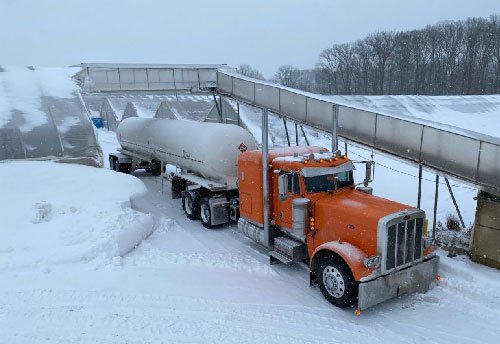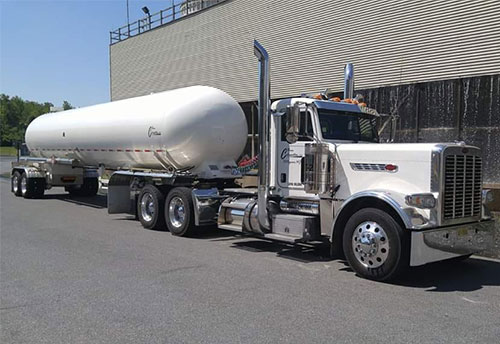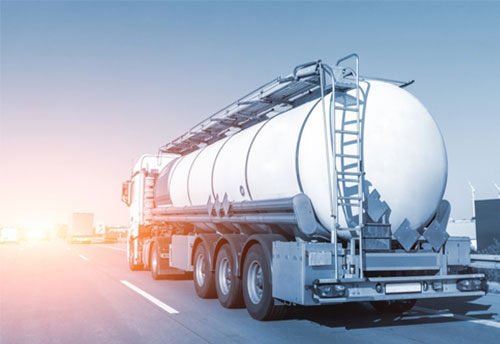LIVE UPDATES
For real-time national and regional weather updates including notifications on conditions that may impact current travel routes, click here.
 With new technological advancements, liquid propane transport is becoming safer, as well as more efficient and environmentally friendly. But what exactly are these technologies, and how are they transforming the way we transport liquid propane (LP)?
With new technological advancements, liquid propane transport is becoming safer, as well as more efficient and environmentally friendly. But what exactly are these technologies, and how are they transforming the way we transport liquid propane (LP)?
C Three Logistics uses the latest technology in all their transport services, including LP transport, to make sure the transports are completed safely and efficiently. We are in constant contact with our drivers, and you get real-time updates on your transport.
Let’s explore the evolution of LP transport logistics, highlight the latest technological advancements, and uncover how they benefit your operations. Whether you’re a seasoned logistics professional or a propane business owner looking to stay ahead, you’ll find valuable insights here.
Transporting liquid propane has come a long way since its early days. Historically, the process was fraught with challenges, including managing temperatures, ensuring safety, and maintaining efficient delivery schedules. Traditional methods often relied on manual tracking and paper-based documentation, making the process slow and prone to human error.
For many years, logistics professionals had to manually calculate delivery routes, monitor inventory levels, and maintain meticulous records. This labor-intensive approach not only consumed time but also increased the risk of mistakes, potentially leading to costly delays or safety hazards. Additionally, the environmental impact of inefficient LP transport methods was a growing concern.
Despite these challenges, the industry continued to innovate, laying the groundwork for the technological advancements we see today. By understanding the evolution of LP transport logistics, we can better appreciate the significance of recent breakthroughs and their potential to revolutionize the industry.
Today, several cutting-edge technologies are transforming LP transport logistics, making it more efficient and reliable than ever before. Let’s take a closer look at some of these advancements and their specific applications in the industry.
GPS tracking: Global Positioning System (GPS) tracking has revolutionized how logistics professionals manage their fleets. By providing real-time location data, GPS tracking allows for more accurate route planning, improved delivery times, and enhanced safety. With GPS, companies can monitor their vehicles’ movements, identify potential issues, and make informed decisions to optimize their operations.
Internet of Things (IoT): The Internet of Things (IoT) is a game-changer for LP transport logistics. IoT devices can collect and transmit data from various points along the supply chain, providing valuable insights into vehicle performance, fuel consumption, and cargo conditions. By leveraging IoT technology, companies can proactively address maintenance issues, reduce downtime, and ensure the safe transport of liquid propane.
Telematics: Telematics combines telecommunications and informatics to provide comprehensive data on vehicle performance and driver behavior. By integrating telematics systems into their fleets, companies can monitor fuel efficiency, track driver hours, and analyze driving patterns. This information can be used to implement training programs, improve safety protocols, and enhance overall efficiency in LP transport logistics.
The integration of these technological advancements into LP transport logistics offers numerous benefits that can significantly impact your operations. Let’s explore some of the key advantages.
Improved efficiency: One of the most significant benefits of technology in LP transport logistics is the improvement in efficiency. With GPS tracking, companies can optimize delivery routes, reducing fuel consumption and travel time. IoT devices provide real-time data on vehicle performance, allowing for proactive maintenance and minimizing downtime. Telematics systems offer insights into driver behavior, enabling companies to implement training programs that enhance productivity.
Enhanced safety: Safety is paramount in LP transport logistics, and technology plays a crucial role in ensuring the well-being of drivers, vehicles, and cargo. GPS tracking allows companies to monitor their fleets in real-time, quickly identifying any issues that may arise. IoT devices can detect potential problems with vehicle performance or cargo conditions, allowing for prompt intervention. Telematics systems provide valuable data on driving patterns, enabling companies to address risky behaviors and implement safety protocols.
Environmental impact: The environmental impact of LP transport logistics is a growing concern, and technology can help mitigate its effects. By optimizing delivery routes through GPS tracking, companies can reduce fuel consumption and lower emissions. IoT devices provide insights into fuel efficiency and vehicle performance, allowing companies to make data-driven decisions that minimize their environmental footprint. Telematics systems enable companies to monitor and improve driving behavior, further reducing fuel consumption and emissions.
The future of LP transport logistics is bright, with several emerging technologies poised to make a significant impact on the industry. Let’s explore some of the trends to watch for in the coming years.
Autonomous vehicles: Autonomous vehicles have the potential to revolutionize LP transport logistics by improving efficiency, safety, and cost-effectiveness. While fully autonomous trucks are still in development, advancements in semi-autonomous systems are already being implemented. These systems can assist drivers with tasks such as lane-keeping, adaptive cruise control, and collision avoidance, making transport operations smoother and safer.
Blockchain technology: Blockchain technology offers a secure and transparent way to track and record transactions along the supply chain. By implementing blockchain, companies can enhance the traceability of their LP transport operations, ensuring the authenticity and integrity of their products. This technology can also streamline administrative processes, reducing the risk of errors and fraud.
Artificial intelligence (AI): Artificial intelligence has the potential to revolutionize many aspects of LP transport logistics. AI-powered systems can analyze vast amounts of data to identify patterns and trends, enabling companies to make data-driven decisions. From optimizing delivery routes to predicting maintenance needs, AI can significantly enhance efficiency and productivity in LP transport operations.
The integration of technology in LP transport logistics is transforming the industry, offering numerous benefits that can significantly impact your operations. From improved efficiency and enhanced safety to reduced environmental impact, these advancements are revolutionizing the way we transport liquid propane.
Now is the time to embrace these technological advancements and stay ahead of the curve. By leveraging the latest tools and systems with C Three Logistics, you can optimize your operations, improve safety, and reduce your environmental footprint. Contact us today to get started!
 Shipping hazardous materials is a critical aspect of many industries but comes with unique challenges and stringent regulations.
Shipping hazardous materials is a critical aspect of many industries but comes with unique challenges and stringent regulations.
Whether you’re a small business owner, a logistics professional, or a fleet manager, understanding how to safely and legally ship hazardous materials is vital for ensuring safety, compliance, and operational efficiency.
Non-compliance can lead to severe penalties, legal ramifications, and catastrophic incidents. Therefore, getting a grasp on hazardous material shipping regulations is not just about adhering to the law; it’s about safeguarding your business and protecting public safety.
Many businesses know that C Three Logistics is the leader for safe, dependable hazardous materials transport. We leverage our extensive experience along with the latest technology to ensure that your hazardous materials are transported to not only meet all regulations, but in a timely manner.
Hazardous materials, often referred to as dangerous goods, are substances that pose risks to health, safety, property, or the environment. These materials are classified based on their physical, chemical, and biological properties. Here are the primary classifications:
Explosives (Class 1): Includes substances like TNT, fireworks, and ammunition.
Gases (Class 2): Comprises flammable, non-flammable, and toxic gases such as propane, oxygen, and chlorine.
Flammable Liquids (Class 3): Encompasses liquids like gasoline, ethanol, and acetone.
Flammable Solids (Class 4): Contains materials like magnesium, sulfur, and matches.
Oxidizing Substances and Organic Peroxides (Class 5): Includes substances like hydrogen peroxide and ammonium nitrate.
Toxic and Infectious Substances (Class 6): Encompasses chemicals like cyanide and medical waste.
Radioactive Materials (Class 7): Includes materials like uranium and medical isotopes.
Corrosive Substances (Class 8): Encompasses acids and bases like hydrochloric acid and sodium hydroxide.
Miscellaneous Dangerous Goods (Class 9): Includes substances that don’t fit into the other classes but are still hazardous, such as dry ice and lithium batteries.
Understanding these classifications is crucial, as they dictate the specific handling, packaging, labeling, and documentation requirements.
Navigating the regulatory landscape is perhaps the most complex aspect of shipping hazardous materials. Different regulations apply depending on the mode of transport (air, sea, or land) and the countries involved. Here’s an overview of the key regulatory bodies and their codes.
Department of Transportation (DOT): In the United States, the Department of Transportation regulates the transportation of hazardous materials through the Pipeline and Hazardous Materials Safety Administration (PHMSA). Key regulations include:
International Maritime Dangerous Goods (IMDG) Code: The IMDG Code governs the transportation of hazardous materials by sea, ensuring safety aboard vessels and at ports. Key elements include:
Technology plays a crucial role in ensuring the safe and compliant shipping of hazardous materials. Here are some tools and technologies to consider:
Hazardous materials management software: Solutions like Labelmaster and Hazmat Software offer comprehensive tools for managing hazardous materials, from classification and labeling to documentation and compliance tracking.
GPS tracking: Real-time GPS tracking systems help monitor the location and condition of hazardous material shipments, ensuring timely interventions if issues arise.
Automated documentation: Tools that automate the generation of shipping documents can reduce human error and ensure accuracy.
Training platforms: Online training platforms provide up-to-date courses on hazardous material regulations and best practices, ensuring employees stay informed and compliant.
With our experience and technology, C Three Logistics is the transport company you can rely on for shipping hazardous materials. Contact us today to learn more.
 The supply chain is the unsung hero of almost every industry, silently ensuring that goods, energy, and resources reach where they are needed the most.
The supply chain is the unsung hero of almost every industry, silently ensuring that goods, energy, and resources reach where they are needed the most.
In a region like the Mid-Atlantic, propane plays a critical role in powering homes, businesses, and industrial ventures. For propane industry professionals and logistics managers, understanding the intricate details of the supply chain is crucial for ensuring a steady, efficient, and cost-effective flow of this essential energy source.
Propane, also known as liquefied petroleum gas (LPG), is a versatile energy source used in a wide range of applications, from heating and cooking in residential areas to refueling fleets and forklifts in industrial settings. The Mid-Atlantic region, encompassing states like Maryland, Delaware, Virginia, and West Virginia, relies on propane to power a significant portion of its energy needs. With its clean-burning properties and suitability for various climatic conditions, propane contributes to the region’s energy security and environmental sustainability.
This guide is designed to take an in-depth look at managing the supply chain for propane in the Mid-Atlantic, discussing everything from transportation to regulatory frameworks, and from storage practices to emerging technologies that revolutionize efficiency.
Understanding the propane supply chain is akin to tracing the lifecycle of an essential resource from its point of origin to the end-user. In the case of propane, the supply chain typically consists of the following stages:
Production and refining: Propane, a byproduct of natural gas processing and crude oil refinement, is produced in large processing plants. These facilities are often located in proximity to natural gas and oil reserves, from where the raw materials are sourced.
Transportation: Once produced, propane must be transported to areas of demand. This involves various modes of transportation, including pipelines, rail cars, trucks, and marine vessels, depending on the distance and available infrastructure.
Storage: Strategically located storage facilities act as crucial nodes in the supply chain. These facilities maintain a reserve that can be drawn upon during peak demand or in case of disruptions in the supply route.
Distribution: From storage, propane is distributed to vendors, retailers, and bulk consumers. This may involve local delivery trucks for residential use or centralized distribution centers for large commercial and industrial customers.
End use: Propane reaches its final destination in homes and businesses.
Logistics forms the backbone of the propane supply chain, and like with any complex system, it is not without its hurdles and potential for improvement.
A significant seasonal aspect affects propane demand, particularly during winter when it is heavily used for heating. Managing the surge in demand requires robust forecasting, efficient logistics planning, and adequate storage and transportation capacities.
Long transit times and cold weather implications can impact the operational efficiency of the supply chain. Dedicated fleet management, route optimization, and the use of advanced tracking systems can help in streamlining operations.
The transportation and storage of propane pose environmental and safety challenges. Ensuring compliance with regulations, investing in safe handling procedures, and adopting eco-friendly fuels and technologies are important areas of focus.
Fluctuating prices of propane and the cost of transportation can put pressure on profit margins. Implementing cost-effective logistics solutions and negotiating favorable contracts with suppliers and carriers are essential for business sustainability.
Efficient transportation and storage are key to managing the propane supply chain effectively. Here are best practices for both areas:
The digital revolution is not bypassing the propane industry. Several technological advancements are shaping the way propane supply chains are managed:
Propane management software: Specialized software solutions offer comprehensive tools for managing inventory, forecasting demand, scheduling deliveries, and improving overall logistics efficiency.
IoT and sensors: The Internet of Things (IoT) is introducing intelligent devices that monitor tank levels, gas quality, and temperature, providing real-time data for decision-making.
Blockchain and smart contracts: Blockchain technology offers a secure and transparent platform for managing transactions and contracts, which can be particularly beneficial for supply chain financing and management.
You can trust C Three Logistics to manage propane transport with attention to detail and safety. Get a free quote today.
 Transporting anhydrous ammonia, a compound vital to agriculture and various industrial processes, carries its own set of complexities and hazards. As global demands grow, the need for stringent safety protocols becomes increasingly apparent.
Transporting anhydrous ammonia, a compound vital to agriculture and various industrial processes, carries its own set of complexities and hazards. As global demands grow, the need for stringent safety protocols becomes increasingly apparent.
C Three Logistics is the leader in the Ohio Valley, along with the Midwestern and Eastern United States, in the transportation of anhydrous ammonia. We have a dedicated fleet for anhydrous ammonia transport, and all our drivers are CETP certified, trained, and experienced.
C Three Logistics is proud to be a partner in Responsible Care®, an esteemed initiative by the American Chemistry Council. This initiative is committed to upholding the highest standards in health, environmental preservation, safety, and security. We are dedicated to fostering a culture of excellence in these areas and ensuring the well-being of our stakeholders.
This is a guide for safety professionals and transport companies toward a path of not just compliance, but of excellence in anhydrous ammonia transportation safety.
Safety must remain at the forefront of anhydrous ammonia transportation logistics for two fundamental reasons. Firstly, its inherent nature as a corrosive, toxic, and flammable substance necessitates exceptional care to avoid environmental, health, and safety risks. Secondly, incidents involving ammonia can have far-reaching consequences, from loss of life and injury to legal and financial repercussions for stakeholders across the logistics chain.
Let’s go into some details about anhydrous ammonia and its transport.
What is Anhydrous Ammonia? Anhydrous ammonia, a nitrogen-based compound with the formula NH₃, is highly soluble in water and used predominantly in agriculture as a fertilizer for soil and as a crucial ingredient in the production of other compound fertilizers. Its importance to food production, as well as in the manufacturing of various pharmaceuticals and other chemicals, underlines the necessity for safe and efficient transportation.
The risks of transporting ammonia: The risks of ammonia transportation are manifold. From leaks or spills that can cause immediate harm to humans and the environment, to the potential for combustion, the scope of potential disasters is alarming. For transport companies, mitigating these risks requires a comprehensive understanding of ammonia’s chemical properties and the development of strategies to handle and transport the substance safely.
Various organizations and government bodies have established a set of regulations and best practices to ensure the safe transport of hazardous materials, including ammonia. These include the US Department of Transportation’s requirements for ammonia transportation and the widely recognized ISO 6750:2020 for cryogenic vessels.
In theory, adherence to safety standards should offer significant protection against incidents. For ammonia, this includes proper packaging, prudent selection of transport methods, and specialized training. However, as the complexity of the logistics chain increases, the need for more sophisticated safety measures becomes more apparent.
The current safety standards, while robust, have limitations. They sometimes leave gaps in the safeguarding of ammonia transportation due to evolving threats such as cybersecurity vulnerabilities in transportation networks. Furthermore, they do not always account for the human element, which remains a critical factor in safety management.
Cost vs. consequence: While there may be a perceived additional cost in implementing advanced safety measures, the consequences of not doing so far outweigh any financial outlays. Proactive investment in safety measures is an investment in the long-term viability of the company and the industry as a whole.
Regulatory considerations: Striving to exceed safety standards positions companies favorably with regulatory bodies. By adopting a progressive approach, companies can influence future standards and ensure a clear alignment with their own existing practices. Furthermore, exceeding these standards can also open doors to new markets and partnerships, where stringent safety practices are becoming a competitive differentiator.
Prioritizing safety in corporate strategy: Corporate strategy that embeds safety as a core value reaps rewards in terms of operational excellence and customer satisfaction. By prioritizing safety, businesses can build resilience and ensure sustainable growth in an industry that is under the constant scrutiny of the public and regulatory authorities.
With the knowledge, experience, and technology C Three Logistics offers, you know your anhydrous ammonia transports will be done safely and efficiently. Contact us for a quote today.
 Time is money, especially in the world of business. Every minute counts and every decision can make a significant impact on profitability.
Time is money, especially in the world of business. Every minute counts and every decision can make a significant impact on profitability.
Distillate fuel is used in transportation for many industries such as agriculture, construction, manufacturing, and more. Businesses in these industries need distillate fuel transportation they can count on.
C Three Logistics offers comprehensive distillate fuel transportation services. Our fleet consists of 14 gasoline tankers, fully equipped to deliver your distillate fuels promptly.
We put safety first. C Three Logistics takes pride in being a partner of Responsible Care®, an initiative spearheaded by the American Chemistry Council. This initiative is dedicated to upholding the highest standards in health, environmental, safety, and security practices. Our drivers undergo comprehensive training and certification through the Certified Employee Training Program (CETP) to ensure they possess the necessary knowledge and skills to handle, transport, and deliver distillate fuels safely and efficiently.
We use advanced technology to ensure the safety of transporting your distillate fuels. Our drivers are in constant contact with us, receiving important safety information about their route and being alerted to weather or traffic issues that may pose hazards. With this data, we work with the drivers to ensure a safe and efficient route. You also have 24/7 access to track the progress of your distillate fuel transportation and can reach out to us with any questions or concerns.
The transportation industry depends on distillate fuels to move people and goods around the country and around the world. Diesel and jet fuels are the primary sources of energy for heavy-duty vehicles, such as freight trucks and airplanes, respectively.
Distillate fuel is a crucial component of many industries, particularly agriculture, construction, and manufacturing. These industries rely heavily on heavy-duty equipment, and distillate fuel is often the preferred choice for powering these machines.
Distillate fuels play a critical role in the agriculture sector, powering the machinery that makes modern farming possible. From tractors to combine harvesters, these machines rely on fuels like diesel and kerosene to operate efficiently. This reliance on distillate fuels has not only increased productivity but also transformed agriculture into a more technologically advanced and efficient industry.
Distillate fuels are essential in the construction industry. They have widespread use in powering heavy machinery and equipment like excavators, cranes, loaders, and generators. Renowned for their exceptional energy density and efficiency, these fuels serve as an ideal power source for meeting the demanding requirements of construction sites.
Distillate fuel burns cleaner and more efficiently than other fuels, making it an environmentally friendly option. Additionally, it has a higher energy content, which means equipment can run for longer periods without needing to refuel. With the increased productivity and reduced environmental impact offered by distillate fuel, it’s no wonder why it is so important to these industries. By investing in distillate fuel, businesses can improve their bottom line while also making a positive impact on the environment.
If your business needs reliable distillate transportation services, get your FREE quote today from C Three Logistics!
 Since 2017, the committed, experienced team at C3 Logistics has delivered liquid asphalt for customers. From our home base in Newfield, NJ, we can safely transport this crucial building material wherever you need it in our East Coast and Midwestern service region.
Since 2017, the committed, experienced team at C3 Logistics has delivered liquid asphalt for customers. From our home base in Newfield, NJ, we can safely transport this crucial building material wherever you need it in our East Coast and Midwestern service region.
We have extensive experience hauling different commodities, including hazardous and temperature-sensitive materials. We know the specific requirements and challenges of transporting liquid asphalt.
Asphalt is a product of crude oil, the resource that gives us gasoline, diesel, kerosene and other fuel oils. Indeed, in the past, oil refiners would sometimes give away asphalt for free as a waste product.
For the last 100+ years, asphalt has been an invaluable commodity for homeowners, private businesses and municipalities. Asphalt works as a binder for pavement, and you’ll find it used in:
Liquid asphalt can also be used as a waterproof sealant. It’s used to make roof shingles and to seal flat roof surfaces.
Asphalt is on New Jersey’s Hazardous Substance List because it has been cited by the American Conference of Governmental Industrial Hygienists (ACGIH), the U.S. Department of Transportation (DOT), The National Institute for Occupational Safety and Health (NIOSH), the International Agency for Research on Cancer (IARC) and National Fire Protection Association (NFPA).
Exposure to asphalt can irritate your eyes, nose, throat and lungs. You may experience headaches, dizziness, nausea or vomiting. Asphalt can cause burns and acne-like lesions, and some asphalt products have been shown to cause cancer in animals. There are also fire hazards associated with asphalt.
With all this in mind, it’s crucial to have safe, professional transportation for your liquid asphalt.
Today, liquid asphalt is typically moved from the supply source to its terminal site via barge and railcar. From there, the material goes into a truck, where it can be delivered to businesses, project sites and other end users.
The railcars that transport liquid asphalt have coils to maintain a temperature in the range of 300 and 325ºF.
Keeping your liquid asphalt at a stable temperature during transportation requires an experienced and committed partner. At C3 Logistics, we have specialized steel and aluminum tankers that can heat liquid asphalt between 325˚ and 500°. We offer customizable delivery options, including multiple tankers for large shipments and a front pump-off option for trailers. We’re located near major ports and distribution centers in the Eastern United States.
Safety is our top priority. You can always feel confident that the C3 Logistics team will diligently handle your liquid asphalt and deliver it securely and promptly wherever you need it in the Midwestern and Eastern U.S.
Our experts are here to move your liquid asphalt and other hazardous materials where they need to go. Contact us today for a FREE estimate.
 When it comes to transporting hazardous materials, you need a transport company with the knowledge, experience, and team to handle your transport with a commitment to following all regulations when it comes to hazmat transportation.
When it comes to transporting hazardous materials, you need a transport company with the knowledge, experience, and team to handle your transport with a commitment to following all regulations when it comes to hazmat transportation.
C Three Logistics stands tall above all other transport businesses. We understand the importance of adherence to hazmat transportation regulations.
Regulations for hazardous materials transport serve multiple purposes. These are the top purposes:
Communication: Regulations involving communication include rules covering shipping papers, marking, labeling, and placarding. There are also regulations that cover training, record-keeping, and planning requirements.
Vehicles and containers: Before being authorized for the transport of hazardous materials, containers must successfully undergo a series of performance tests. Regulatory standards establish criteria regarding materials, construction, and maximum capacity. These requirements ensure compliance and safety throughout the transportation process.
Emergency response: Each transport must have emergency response information in its shipping papers so that, in the event of an emergency, first responders know the material they are dealing with and also have information on best practices for handling leaks, spills, fires, or other emergencies.
At C Three Logistics, safety is our top priority when it comes to transporting hazardous materials. We hold a steadfast commitment to ensuring the utmost precautions are taken throughout the entire process.
As a proud partner of Responsible Care®, an esteemed initiative led by the American Chemistry Council that prioritizes health, environmental sustainability, safety, and security standards, we are committed to providing comprehensive and ongoing training for our dedicated employees and drivers.
Our drivers possess exceptional expertise in the safe transportation of hazardous materials. They hold valid licenses, certifications, and have successfully completed the rigorous Certified Employee Training Program (CETP). Moreover, they have received comprehensive training in both pump and air transportation methods, ensuring utmost proficiency and adherence to industry standards.
C Three Logistics drivers responsible for transporting materials such as anhydrous ammonia undergo comprehensive training that includes the proper utilization of personal protective equipment (PPE) and the implementation of best practices for managing any potential emergencies that may occur during transportation and delivery.
At C Three Logistics, we harness the power of technology to elevate our services and enhance safety best practices. Through state-of-the-art equipment and software, we maintain seamless communication with our drivers 24/7. This empowers us to efficiently support them in delivering your hazardous materials on time, while navigating around traffic, inclement weather, and any other potential obstacles that could compromise the safety and promptness of the delivery.
Our advanced communication technology empowers us to offer round-the-clock dispatch with rapid response time. This invaluable capability ensures that our customers receive up-to-the-minute information about their load and transportation, along with instant invoicing.
With expert service from C Three Logistics, your hazardous transport services are in good hands. Request a FREE quote from us today.
 Distillate fuels are used in a variety of ways all around the U.S. When they need to be transported, you need a logistics and transport business with the experience and know-how to get it done.
Distillate fuels are used in a variety of ways all around the U.S. When they need to be transported, you need a logistics and transport business with the experience and know-how to get it done.
Since 2016, that company has been C Three Logistics. We have a fleet of 14 gasoline tankers ready to promptly deliver your distillate fuels. We offer a variety of pump options to cater to your specific needs. We understand that customers of distillate fuels, such as ferry services or construction companies, have varying fuel requirements throughout the year. That’s why we provide adaptable delivery options tailored to both seasonal and nonseasonal demands.
Distillate fuel is a diverse category that encompasses one of the petroleum fractions obtained through conventional distillation processes. This liquid fuel is typically derived from crude petroleum and includes diesel fuels and fuel oils. It plays a crucial role as an energy source for internal-combustion vehicles equipped with either mechanical or electric transmissions. Additionally, it finds application in automobiles, locomotives, agricultural machinery, space heaters, and power generators.
Petroleum-based oil is a broad term typically used to describe non-synthetic oils utilized for lubrication purposes. One example is motor oil, which is commonly used to maintain the performance of your car’s engine.
You can’t hire just any transport provider to manage the transport of your distillate fuels.
You need a transportation company that knows the regulations and safety requirements for transporting distillate fuels. That’s where C Three Logistics stands tall above other transportation companies.
C Three Logistics is proud to be a partner in Responsible Care®, an initiative led by the American Chemistry Council. This initiative is committed to upholding the highest standards in health, environmental, safety, and security practices. All of our drivers undergo rigorous training and certification through the Certified Employee Training Program (CETP). We ensure that our drivers are equipped with the necessary knowledge and skills to handle, transport, and deliver distillate fuels safely and efficiently.
We also leverage our advanced technology to uphold safety in transporting your distillate fuels. When your distallate fuels are being transported, we are in contact with our drivers 24/7. This ensures that they have important safety information about their route, and they are alerted to weather or traffic issues that can pose hazards. With this data, we work with the drivers to make sure their route is safe and efficient. You also have 24/7 access to the progress of your distillate fuel transport, so you can be assured that it is being handled in a safe and timely matter and you can contact us with any questions or concerns you may have.
When you need distillate transport services, C Three Logistics is the logistics and transport company you can count on. Get in touch with us today for your FREE quote.
 Chemical hauling is a highly specialized field when it comes to logistics and transport services. There are stringent government regulations that apply to the drivers, the vehicles, how the chemicals are handled, what roads drivers can use, and more.
Chemical hauling is a highly specialized field when it comes to logistics and transport services. There are stringent government regulations that apply to the drivers, the vehicles, how the chemicals are handled, what roads drivers can use, and more.
That’s why you need an experienced, knowledgeable logistics and transport company for your chemical hauling needs. For businesses from the Ohio Valley to the Mid-Atlantic Region to New England, that company is C Three Logistics! We provide unmatched services thanks to our commitment to safety and communication.
Safety is of utmost importance when it comes to logistics and transportation of chemical products. At C Three Logistics, we prioritize and take this matter seriously. As a proud partner in Responsible Care®, an initiative of the American Chemistry Council dedicated to upholding health, environmental, safety, and security standards, we ensure that our operations align with the highest industry standards.
Through our commitment to Responsible Care®, we go beyond mere compliance and actively engage in regular training programs for our employees and drivers. This ensures that they stay up-to-date with the latest safety protocols and best practices in handling chemical products. By continuously investing in the development and education of our team, we maintain a strong safety culture that fosters a secure and reliable transportation service for our valued clients.
Every one of our chemical hauling drivers are highly skilled in the safe transportation of your chemical products. Each driver is certified and has successfully completed the comprehensive Certified Employee Training Program (CETP). They are extensively trained in pump and air operations. Additionally, C Three Logistics provides a lease-to-purchase option for owner/operators. Your cargo is in capable hands, ensuring reliable and efficient transportation.
Rest assured, when you choose C Three Logistics, you are partnering with a company that will never cut corners when it comes to safety.
Chemical hauling involves more than the trucks and the drivers. It’s a team effort here at C Three Logistics.
At C Three Logistics, we leverage the latest technological advances to ensure that your transport services are not only easy and worry-free but also tailored to your specific needs.
Our dedicated team is in constant communication with our drivers, available 24/7, to provide unparalleled support and seamless coordination. If there are weather or traffic problems on their route, we can keep them informed and work with them to keep the delivery on-time and safe.
With our advanced communications technology, we proudly provide round-the-clock dispatch services, ensuring a swift response time. Moreover, we empower our valued customers with real-time load and transport updates, along with instant invoicing. Experience seamless efficiency and unparalleled convenience with our cutting-edge solutions.
It is this level of responsiveness and attention to detail that sets us apart and makes C Three Logistics the preferred choice for businesses seeking reliable and efficient logistic and transport solutions.
C Three Logistics is a leader in providing safe, dependable chemical hauling. Contact us today for your FREE quote.
 C Three Logistics offers unparalleled transport services for hazardous materials, including liquid petroleum products.
C Three Logistics offers unparalleled transport services for hazardous materials, including liquid petroleum products.
By choosing C3 Logistics for your liquid petroleum transport service, you gain access to our highly skilled team of drivers, dispatchers, mechanics, and logistics experts. Our expertise ensures efficient operations and peace of mind for your transportation requirements.
C3 Logistics offers advanced technology that keeps us in constant contact with our drivers, ensuring seamless communication 24/7. This enables us to efficiently manage their routes on the go, helping them navigate traffic and keeping your transportation schedule on track. Additionally, we utilize this technology to keep you informed about the status of your transports.
Let’s begin with where most liquid petroleum products get their start: crude oil. Crude oil is transported from production operations to refineries using various means such as tankers, barges, rail tank cars, tank trucks, and pipelines. Refineries process the crude oil to obtain various petroleum products, with one of the major products being liquid petroleum such as gasoline and diesel.
Those same modes of transport deliver refined petroleum products to fuel marketing terminals and petrochemical industries.
That is where C Three Logistics comes in. The C Three Logistics team consists of skilled drivers trained in both local and long-distance transportation, proficient in handling a wide range of commodities. Additionally, our drivers are certified with CTEP training, guaranteeing the delivery of your liquid petroleum products with top-notch service.
Our location in Newfield, NJ, places us in close proximity to key ports and distribution centers, facilitating efficient transportation and logistics services. This strategic advantage enables us to provide faster and more responsive solutions for the materials we transport.
Tanker trucks, like the ones utilized by C Three Logistics, play a vital role in transporting liquid petroleum products. Although they operate similarly to rail transportation, their primary function is to deliver refined petroleum products, such as gasoline, to distribution points like gas stations. Unlike rail transport, trucks offer the advantage of enhanced flexibility as they can navigate roadways instead of relying solely on established railways. We leverage our logistics and communication technology to maximize efficiency when it comes to your transport.
Liquid petroleum products also include propane. Around 90% of the propane fuel supply in the United States is produced domestically, mainly sourced from natural gas and crude oil processing.
Approximately 70% of the nation’s propane supply is derived from natural gas. Through a separation process, propane and butane are extracted from other gases.
During the stabilization process of crude oil refining, propane is produced as a by-product when separating heavier hydrocarbons. Unlike gasoline and diesel, propane is lighter and more readily extracted from other petroleum derivatives. Additionally, this process yields kerosene and heating oil.
At first, propane is compressed and stored in liquid form, which is how it’s transported by C Three Logistics and later delivered to your home’s propane tank by your propane delivery service. However, as it is transported from the propane tank to your home through gas lines, it returns to its gaseous state.
Our experts are here to help you get your liquid petroleum and other hazardous materials where they need to be. Contact us today for a FREE quote.